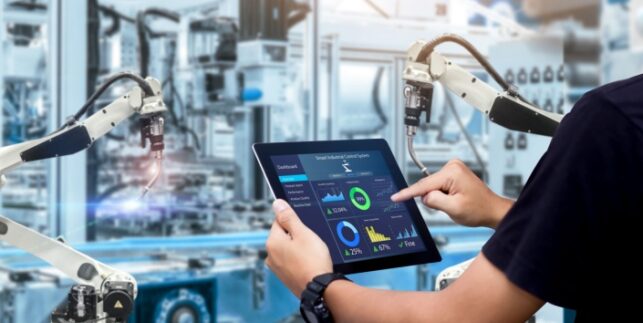Increase Production Efficiency with Real-Time Data

Digital transformation in manufacturing is creating new opportunities to improve shop floor operations. Advanced sensors and IoT (internet of things) devices can provide the data to facilitate greater efficiency at every stage of production.
However, for many manufacturing companies, there is still a significant time gap between when shop floor data is created and when it is collected, analyzed, and acted on. This lag means machines and workers are continuing to operate with suboptimal processes even though the data they need to improve their efficiency has been recorded.
Access to this data in real time is key to optimizing production efficiency. By implementing a real-time operational intelligence (RtOI) system, manufacturing leaders can respond more quickly to problems and more effectively allocate resources to maximize production efficiency.
Elevate Industry 4.0 tools with systems integration
To stay competitive in modern manufacturing, factories must embrace digital transformation. Advanced Industry 4.0 technologies like IoT, cloud solutions, and intelligent tools allow manufacturing leaders to maintain unprecedented insight into their operations 24/7, allowing them to keep production up and running with fewer interruptions.
However, simply adding sensors and other advanced Industry 4.0 technologies to monitor machines without integrating those tools together means real-time insights will be missed.
“The first step towards achieving fully realized real-time operational intelligence is by integrating advanced technology on the shop floor,” says Ronald Van Loon, CEO of Intelligent World and digital transformation expert. This requires all the data generated by these advanced tools to be collected into a central system.
“A single source of truth enhances visibility for every unit of production, empowers the workforce, and ensures real-time information is a core component in knowledge sharing and decision making while eliminating communication bottlenecks to optimize productivity and performance,” says Van Loon.
An end-to-end view of the organization should include everything from machine productivity to energy usage to real-time labor reporting. This data should then be accessible by any qualified person who needs it, at any time.
Production efficiency impacts of RtOI
Reports and dashboards based on post-mortem data may be helpful in understanding how a day went, but they do not have the ability to shift a day from bad to good. With a real-time operational intelligence system, everything from maintenance to production can be made more efficient.
When collected into an RtOI system, the real-time operational data produced by advanced sensors can influence factory operations in multiple ways. One example is alerting factory supervisors about problems before they lead to machine failure. This smarter preventive maintenance can improve uptime, enable machine-on repairs, and reduce the total number of repairs.
Another way real-time data can be used is to facilitate higher precision in the production process. Real-time monitoring, says Mike Nager, Manager at Festo Didactic and industry 4.0 expert, ensures “product quality is by design instead of by inspection and as such immediately reduces the waste represented by out-of-spec product at the end of the line.”
“An example is product drying,” Nager adds. “To make sure the product meets spec, in traditional processing, processors tend to err on the side of caution.” Caution that is based on a lack of real-time data leads to an inefficient drying process.
The inefficiencies in an inspection-based process have a negative financial impact, as Nager explains: “Let’s say a grain should have no more than 15% moisture by weight,” he says. “They will dry to 12% because that’s what feels safe, with the deviations normally present.”
This level of caution has two avoidable costs: “The cost of that extra 3% might be 20% or 30% more. And because the product is sold by weight, they will earn less money when they sell it than if it had 15% moisture.”
Monitoring moisture levels in real time, Nager says, “avoids bad products by making adjustments to ensure quality, eliminates unnecessary drying costs, and allows full revenue to be collected.”
This is an industry-specific example, of course, but it illustrates how real-time data can make a major difference in any manufacturing environment.
RtOI increases overall equipment effectiveness (OEE)
A real-time operational intelligence system will improve multiple key metrics in the manufacturing process. However, this is not simply speculation and theory. The impacts of real-time data in manufacturing have been realized by multiple companies.
Magic Polo Plast, a plastics manufacturer in Ma’anit, Israel, adopted the Matics RtOI system several years ago.
“First and foremost,” says Magic Polo Plast CEO Eran Appel, “the Matics system gave us the ability to see what was happening on the production floor and to not rely on our gut feelings.”
The Matics RtOI system allowed the manufacturer to better analyze its data. “The more accurate the data, the more accurate the solutions,” says Appel. “Magic no longer bases decisions on gut feelings – but on real-time data. This ability to drill down and to understand what has happened, how and why, continuously helps us reach efficiency and save money.”
Improve your production efficiency with RtOI
Real-time operational intelligence has produced measurable production efficiency improvements for other manufacturers as well. Those results include an OEE increase of 15% in one case, a 30% increase in another, and even a company that achieved 85% OEE.
If you are interested in learning more about how Matics’ RtOI system can improve your production efficiency, request a demo today.





